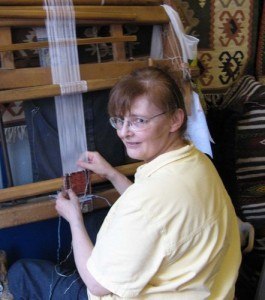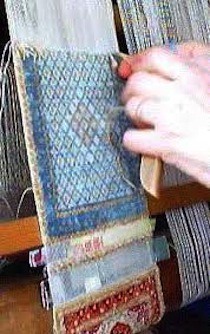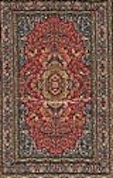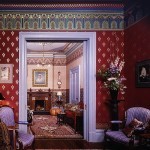Rugs – The Real Thing
Note from Susan
If you are going to lay out big bucks for a hand-knotted carpet, this guide by Laura and Ludwina will help you know the real thing.
Dollhouse Miniature Carpets And Rugs
By Laura and Ludwina
Rugs: The Real Thing. As in real-life, I cannot imagine a doll’s house without carpets. Carpets or rugs as a lot of us call them, give a warm and cozy feeling to any room. With this guide I do not want to explain about styles and periods, but about the different techniques used to make miniature carpets, with the hope that if you understand the length of time and the level of skill required to make some of these carpets you will appreciate their value.
You can find a carpet for every period or style. If you want your dollhouse to be authentic you will have to do some research to find out what style of carpets were used in the period you are working in. But you also can go for a piece with colors which match the rest of the room’s decor.
 It makes me very sad when I see the low prices petit point carpets sell for sometimes, and once I saw a machine made piece sell for quite a high price. Therefore, I will also give you some tips on how you can see the difference in a handmade or machine-made carpet.
It makes me very sad when I see the low prices petit point carpets sell for sometimes, and once I saw a machine made piece sell for quite a high price. Therefore, I will also give you some tips on how you can see the difference in a handmade or machine-made carpet.
The easiest to make is a machine-woven textile. If you can find a narrow strip or ribbon with a nice design, you can simply fray both of it’s ends to create a miniature carpet. When you have a thin woven piece of ribbon it will even work for 1/4 inch scale.
If you have a bigger piece of textile you will have to cut the edges to the size you need. You can glue under the edges so they will not fray.
A lot of ‘Turkish woven’ carpets are sold for dollhouses. These are the same machine weaving techniques as a designed ribbon but are cut up and sold as ‘carpet’, they have a fringe on both sides and exist in several sizes and a big range of designs and colors. Those which I have seen are all machine woven in a synthetic fiber. Sometimes they are shiny to give a ‘silky’ look, or have added details such as gold color thread.
If you look well you will see that the color of the design is positive / negative for front and back. This is very typical for machine-woven pieces. All the different colors ?float? on the backside in layers where they are not needed to make the design in the front.
There are also machine woven pile carpets. These pile carpets are usual bigger. I have not yet seen these special made as dollhouse carpets: They are thicker than the previous type and are used for chairs or as coasters or place mats.
How can you see the difference between a machine-made or a handmade pile carpet? Always look at the backside. If there is no picture of the backside, ask for one. The backside will show a different color than the front. When a piece is without much color it will have the positive/negative look. For example when the front is blue it will be red on the back. And where the front is red it will be blue on the back. When more colors are used it will look more complicated on the backside.
When you look at a handmade pile carpet on the backside you will see horizontal rows on the warp which is originally vertically on the loom. In machine pile carpet you have vertical rows on a vertical warp. But these miniatures are often smaller pieces cut of a bigger weaving and it is often difficult to see which way the warp was. These pieces will have a machine made overcast to finish the cut off edgings.
Another way to make a miniature carpet is printing.There are some different possibilities in printing: on flocked paper or on textile. I am no expert in printing so I can not give you advise on ‘how to’ make one, but I am sure that a good-looking carpet can be made like this quickly and inexpensively.
If you work in 1/4 inch scale this is another way to have a carpet in your 1/4inch scale room. Using Bunka: By fraying out Bunka you get a fine kinky thread, what you can glue on a paper or textile base, using the different colors to make your design.
There are crocheted and braided rugs. For a more rustic style or kitchen they will look great. They look similar back and front.
Some other techniques to make miniature carpets are: punched or hooked carpets, created by making a ‘piled’ design on a piece of cloth or mesh with French knots or using a punching tool or hook. The backside of these different techniques will look very similar on the back. Here again you should see the same color front and back. Practice and skill is required to make a fine piece which is finished nicely and lies flat.
Some very dedicated miniaturists make their own carpets in ‘petit point’. There are some very nice kits and several books with patterns of miniature carpets available. The accuracy of the scale will depend on the size of the gauze you are working on and the material used to make the embroidery. The color and design will be the same on the front and back. You can be sure it takes a lot of time and skill to make a nice embroidered miniature carpet. A piece made in a nice design and color by somebody with experience is a piece of art and I feel a lot of respect for those artists!
And now the “hand knotted” carpets. To make a real pile carpet you need a loom. Warp is stretched on the loom and weft made. The design is made by a line of knots, then the weft is added and pressed down. Finally the knots are clipped to get an even thickness all over the pile. Working this way line after line to build up the carpet.
A small carpet is not the same as a miniature carpet. Everything must be down-sized in proportion and the design must be miniature as well. The weaving is about as thick as a nickel and the pile is the same thickness, so the total thickness is 2 five-cent pieces, one stacked on the other. With a ?small carpet,? the total thickness is only equal to one nickel.
We hope by understanding a little more about techniques used in miniature carpets you will be able to value them in proportion to the work required to make them.
Laura and Ludwina
Susan Downing, with Patrick Owens
_________________________________________________________________________
I invite you to visit my Etsy Shop where I offer many accessories and pieces of furniture in 1:12 scale.








